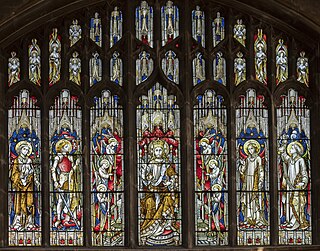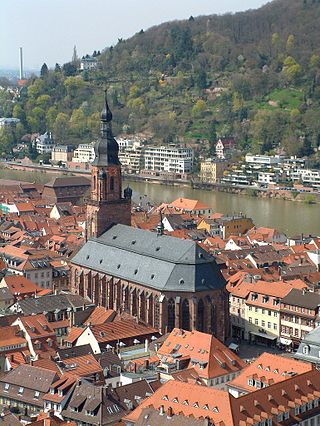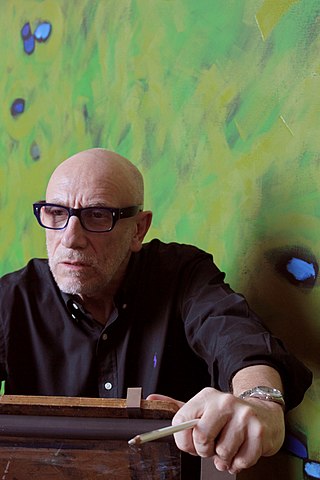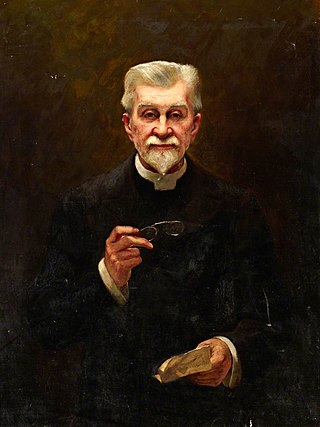
Whitechapel is a district in East London and the future administrative centre of the London Borough of Tower Hamlets. It is a part of the East End of London, 3.4 miles (5.5 km) east of Charing Cross. Part of the historic county of Middlesex, the area formed a civil and ecclesiastical parish after splitting from the ancient parish of Stepney in the 14th century. It became part of the County of London in 1889 and Greater London in 1965. The district is primarily built around Whitechapel High Street and Whitechapel Road, which extend from the City of London boundary to just east of Whitechapel station.

Stained glass is coloured glass as a material or works created from it. Throughout its thousand-year history, the term has been applied almost exclusively to the windows of churches and other significant religious buildings. Although traditionally made in flat panels and used as windows, the creations of modern stained glass artists also include three-dimensional structures and sculpture. Modern vernacular usage has often extended the term "stained glass" to include domestic lead light and objets d'art created from foil glasswork exemplified in the famous lamps of Louis Comfort Tiffany.

The Whitechapel Bell Foundry was a business in the London Borough of Tower Hamlets. At the time of the closure of its Whitechapel premises, it was the oldest manufacturing company in Great Britain. The bell foundry primarily made church bells and their fittings and accessories, although it also provided single tolling bells, carillon bells and handbells. The foundry was notable for being the original manufacturer of the Liberty Bell, a famous symbol of American independence, and for re-casting Big Ben, which rings from the north clock tower at the Houses of Parliament in London.

The Royal London Hospital is a large teaching hospital in Whitechapel in the London Borough of Tower Hamlets. It is part of Barts Health NHS Trust. It provides district general hospital services for the City of London and Tower Hamlets and specialist tertiary care services for patients from across London and elsewhere. The current hospital building has 845 beds and 34 wards. It opened in February 2012.

Hardman & Co., otherwise John Hardman Trading Co., Ltd., founded 1838, began manufacturing stained glass in 1844 and became one of the world's leading manufacturers of stained glass and ecclesiastical fittings. The business closed in 2008.

Clayton and Bell was one of the most prolific and proficient British workshops of stained-glass windows during the latter half of the 19th century and early 20th century. The partners were John Richard Clayton (1827–1913) and Alfred Bell (1832–1895). The company was founded in 1855 and continued until 1993. Their windows are found throughout the United Kingdom, in the United States, Canada, Australia and New Zealand.

The Church of the Holy Spirit is the largest church in Heidelberg, Germany. The church, located in the marketplace in the old town center, was constructed between 1398 and 1515 in the Romanesque and Gothic styles. It receives 1–3 million guests annually, making it among the most visited churches in Germany.

Whitechapel High Street is a street in the Borough of Tower Hamlets in the East End of London. It is about 0.2 miles long, making it "one of the shortest high streets in London". It links Aldgate High Street to the south-west with Whitechapel Road to the north-east, and includes junctions with Commercial Street to the north and Commercial Road to the east.

Saint Augustine's, Kilburn, is a Church of England church in the area of Kilburn, in North London, United Kingdom. Because of its large size and ornate architecture, it is sometimes affectionately referred to as "the Cathedral of North London", although the church is not a cathedral in any official sense.
St. Michael's AnglicanChurch is a historic church and the oldest surviving religious structure in Charleston, South Carolina. It is located at Broad and Meeting streets on one of the Four Corners of Law, and represents ecclesiastical law. It was built in the 1750s by order of the South Carolina Assembly. It is listed on the National Register of Historic Places and is a National Historic Landmark.

Brian Clarke is a British painter, architectural artist and printmaker, known for his large-scale stained glass and mosaic projects, symbolist paintings, set designs, and collaborations with major figures in Modern and contemporary architecture.

St Mary's, Staines, is a Church of England parish church in the town and parish of Staines-upon-Thames, in the Spelthorne borough of Surrey and the Greater London Urban Area. The parish is in the Archdeaconry of Middlesex in the Diocese of London. The church building is on an unusual rise against the Thames at the west end of the town. It has been a Grade II* listed building since 11 August 1952.

Saint Mary Matfelon church, popularly known as Saint Mary's, Whitechapel, was a Catholic then after the English Reformation a Church of England parish church on Whitechapel Road, Whitechapel, London. It is repeatedly supposed by many works and oral histories that the church was covered in a lime whitewash, which gave the chapelry (district) its common name, Whitechapel. Around 1320, it became called St Mary Matfelon. About that time it became a parish in its own right but its priest for many years was a nominee of the Rector of Stepney. The church's earliest known priest was Hugh de Fulbourne in 1329. Last rebuilt in the 19th century, the church was firebombed during the Blitz leading to its demolition in 1952. Its nave's stone footprint and graveyard – its headstones removed – are the basis of Altab Ali Park on the south side of the thoroughfare.

Preston Minster, formally the Minster Church of St John the Evangelist, is in Church Street, in the centre of Preston, Lancashire, England. From its origin it has been the parish church of Preston. It is an active Anglican church in the deanery of Preston, the archdeaconry of Lancaster and the diocese of Blackburn. Its benefice is united with that of St George, Preston. St John's is recorded in the National Heritage List for England as a designated Grade II* listed building.
Peter Mollica is an American stained glass artist.
Francois Pierre Fourmaintraux (1896-1974) was a renowned glass artist who is credited with having introduced the dalle de verre technique to the UK and having taught other influential glass artists such as Dom Charles Norris.
Johannes Schreiter is a German graphic artist, printmaker, designer of stained glass, theoretician and cultural critic. Born in Buchholz in 1930, Schreiter studied in Munster, Mainz, and Berlin, before receiving a scholarship from Friedrich-Ebert-Stiftung in 1958. His invention of the Brandcollage in 1959 first brought him to broader cultural attention, and in 1963 he became professor of Painting and Graphic Art at the Frankfurt/Main School of Decorative Arts, and later Rector of the same. He was awarded the Bundesverdienstkreuze, the highest civilian honour granted by West Germany, in 1979.

John Fenwick Kitto was an English Anglican clergyman and author. He founded and participated in various charitable causes, with a focus on London's East End. He served in positions including Rector of Whitechapel, Rector of Stepney, Vicar of St Martin-in-the-Fields, and Honorary Chaplain to the Queen.



















